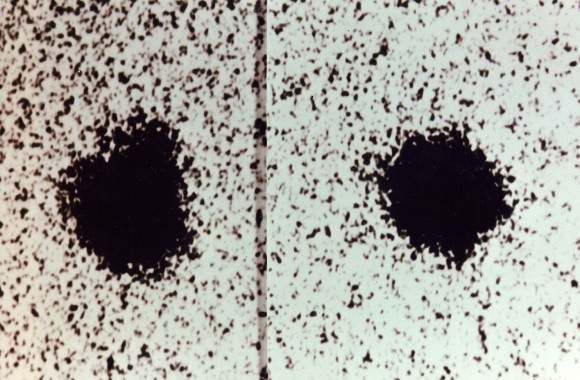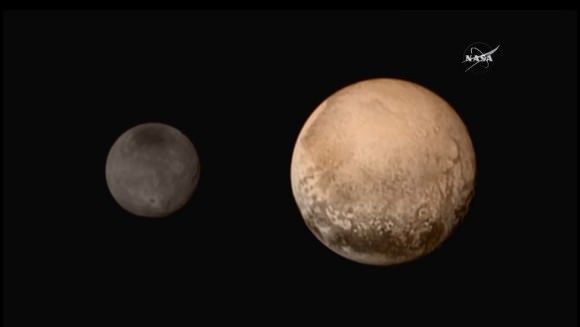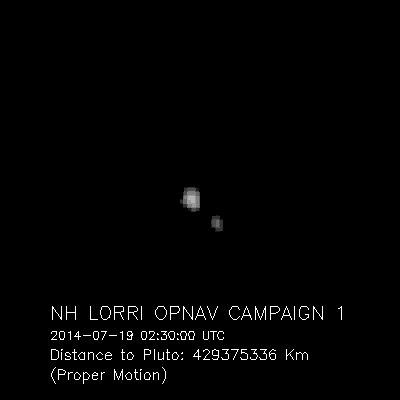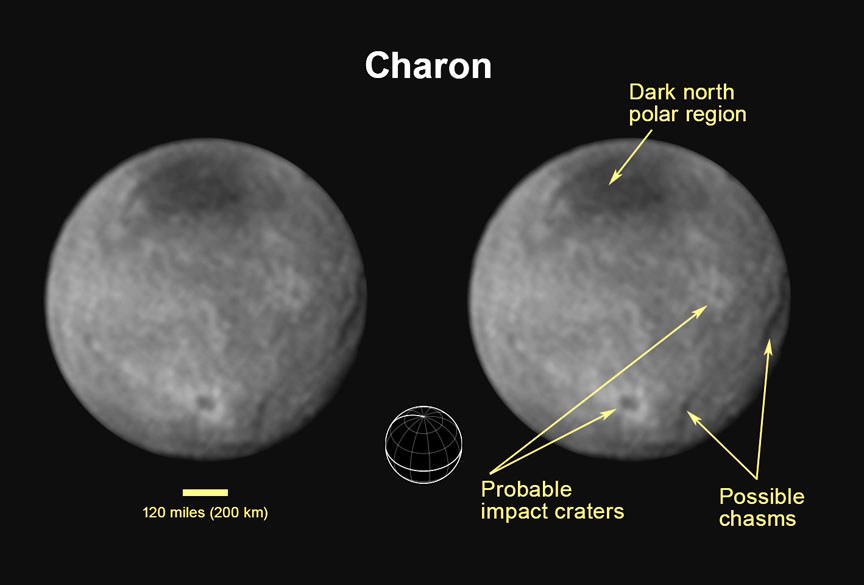Beginning in 1978, astronomers began to discover that Pluto – the most distant known object from the Sun (at the time) – had its own moons. What had once been thought to be a solitary body occupying the outer edge of our Solar System suddenly appeared to have a system with a large moon Charon. And as time went on, a total of four moons would be discovered.
Of these, Charon is the largest and most easily observed, hence why it was discovered first. In addition to being the biggest of its peers, its also quite large in comparison to Pluto. As such, Charon has always had something of a unique relationship with its parent body, and stands apart as far as objects in the outer Solar System are concerned.
Discovery:
Charon was discovered on June 22nd, 1978, by astronomer James Christy at the United States Naval Observatory (USNO) in Washington, D.C. While observing photographic plates taken by the 1.55-meter (61 in) USNO’s Flagstaff telescope two months prior, he observed a slight elongation which appeared periodically, which was later confirmed using plates that dated back to 1965.
Subsequent observations of Pluto determined that the bulge was caused by a smaller accompanying body orbiting the planet, the periodicity of which corresponded to Pluto’s rotation period. His discovery was formally announced to the world on July 7th, 1978 via the IAU, which led to a reassessment of Pluto mass and characteristics, which had previously been attributed to Pluto alone.

Name of Charon
Shortly after being discovered, Charon was given the temporary designation of S/1978 P 1, indicating the year of discovery and the fact that it was the first satellite observed around Pluto (hence P 1). Christy originally suggested the name Charon because of his wife’s name “Char”. His colleagues at the Naval Observatory proposed Persephone – the queen of the underworld in the Greek pantheon – for the sake of mythological symmetry.
However, Christy remained committed to Charon, especially once he learned that the name also referred to a character from Greek mythology. As the ferryman of the dead, Charon is closely associated with Hades of the Greek pantheon, whom the Romans identified with their god Pluto. The name was officially adopted by late 1985 and announced by January 3rd, 1986.
Size, Mass and Orbit
Charon’s diameter, as estimated by the New Horizon’s space probe, is 1,208 kilometers (751 mi) – making it just over half the size of Pluto. It’s mass and volume are estimated to be 1.52 ± 0.06 x 10²¹kg and 9.027×108 km3.
Prior to 2005, scientists were limited to estimates concerning Charon’s mass, which were derived by subtracting it from the total mass of the Plutonian system. However, the discovery of the outer moons (Hydra, Nix, Kerberos and Stix) allowed for accurate assessments of the masses of every individual body in the Plutonian system. Meanwhile, mutual occultations of the system’s bodies have revealed their sizes.

Charon and Pluto share an odd orbital relationship. Rather than the one orbiting the other, as with other systems, these two bodies orbit each other every 6.387 days, and appear to orbit a common center of gravity.
The two bodies are also gravitationally locked, which means that they always keep the same face pointed towards the other, a phenomena which is tantamount to being mutually tidally-locked. The average distance between Charon and Pluto is 19,570 kilometers (12,160 mi).
Composition
Based on spectral data obtained in the 1980s, astronomers have been able to calculate the density of Charon, which is approximately 1.65 ± 0.06 g/cm. These measurements suggest a composition of 55% rock to 45% ice, compared to Pluto’s somewhat denser composition of about 70% rock and 30% ice. And whereas Pluto’s surface is composed of nitrogen and methane ices, Charon’s surface appears to be dominated by the less volatile water ice.
In 2005, Robin Canup of the Southwest Research Institute’s Planetary Science Directorate in Boulder, Colorado, published simulation work that suggested that Charon could have been formed by a collision between Pluto and an object from the Kuiper belt. Much like the collision with Earth that formed the moon, this event would have taken place roughly 4.5 billion years ago, with the object blasting off much of Pluto’s outer mantle to form Charon.
However, such an impact would likely have resulted in an icier Charon and rockier Pluto than scientists have found. Hence, it is now thought that Pluto and Charon may have been two bodies that collided before going into orbit about each other, which would have been violent enough to boil volatile ices (like methane) off Charon, but not violent enough to have destroyed either body.
Interesting Facts
Unlike Pluto’s moons of Hydra and Nix, Charon is not oblong in shape. Instead, the moon is sufficiently massive to have collapsed into a spheroid shape under its own gravity. In the 1990s, images taken by the Hubble Space Telescope of Pluto and Charon showed them being resolved into separate disks for the first time.
Later, the development of adaptive optics made it possible to resolve Pluto and Charon into separate disks using ground-based telescopes. This allowed for the Gemini Observatory to gather several detailed images of Charon, which suggested the presence of active cryogeysers on the surface. The same observations indicate that Charon also appears to have no atmosphere.

In August 2014, the New Horizons spacecraft captured consecutive images of the Pluto-Charon system as it approached it. The images were put together in an animation (shown above). Not only were they the best images of Charon to date; when animated, they also managed to beautifully demonstrate how Charon and Pluto orbit each other.
And then in January 2015, New Horizons captured a full 6-day rotation period of Pluto and Charon, clearly showing both objects orbiting around their common barycenter. As with the rest of the Pluto system, Hydra was imaged by NASA’s New Horizons spacecraft in February of 2015. When New Horizons conducts its flyby at 7:49:57 a.m. EDT, July 14, 2015, it will provide the most detailed images of Hydra and the Pluto system to date.
Universe Today has articles on Pluto’s moon Charon and Pluto’s moon Charon has geysers too.
For more information, take a look at these websites pages for Pluto and Charon and Charon.
We have several interesting articles on Pluto’s moon of Hydra. Here’s one on the First New Images of Pluto from New Horizons, and New Horizons Now Close Enough to See Pluto’s Smaller Moons.
Do not forget to tune in to Astronomy Cast’s episode on Pluto and the icy Solar System.


So the chasms are about opposite the Pluto side…. seems tidally related to me….
I think the polar darkness would be a secondary affect of the atmospheric bleeding from Pluto and the debris from events in the outer Pluto system being swept up and leaving the polar area clear. An old surface so to speak, aged by space weathering and radiation on ices. Overall the relatively dim Charon seems to have an older surface than Pluto (except for maybe the dark regions they say could be highly affected tholins from long term exposure to UV of methane.)
thanks. super interesting system. can’t wait for more.